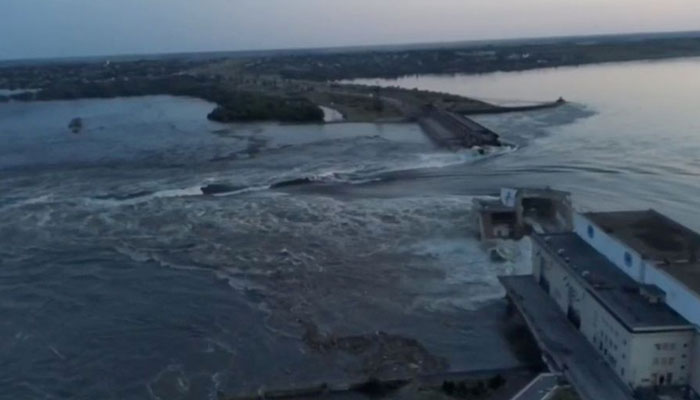[ad_1]

In southern Ukraine, a major dam held by Russia was targeted in an attack on Tuesday, causing a deluge of water that flooded twenty-four villages and necessitated the evacuation of 17,000 people.
The incident has raised concerns about a potential humanitarian disaster. As Moscow and Kyiv exchange accusations, Washington has warned of a high likelihood of casualties resulting from the destruction of the Kakhovka dam, which is situated on the frontline and supplies cooling water to Europe’s largest nuclear plant.
Ukrainian authorities assert that the dam’s destruction, which occurred during the early stages of the war and was seized by Russia, was an attempt by Moscow to hinder Ukraine’s anticipated offensive, emphasising that their plans remain unaffected. In response to the gravity of the situation, a UN Security Council emergency meeting has been scheduled following requests from Russia and Ukraine.
The United Nations has cautioned that hundreds of thousands of individuals on both sides of the frontline could be impacted by the devastating consequences. In the largest population centre nearby, Kherson, people have fled to higher ground as the Dnipro River swells with water pouring in from the dam. The situation has escalated rapidly, with Lyudmyla, who was transporting a washing machine on a cart attached to an old Soviet car, remarking, “There is shooting, now there is flooding.” Sergiy echoed the sense of impending doom, stating, “Everything is going to die here,” as the city faces an influx of water resulting from the breached dam.
According to Ukrainian authorities, 17,000 individuals have been evacuated, and a total of 24 villages have been submerged. Prosecutor General Andriy Kostin revealed that over 40,000 people are at risk of flooding, with an additional 25,000 individuals requiring evacuation on the Russian-occupied side of the Dnipro River.
Ukrainian President Volodymyr Zelensky accused Russia of deliberately blowing up the dam, expressing concern about the potential flooding of up to 80 settlements and calling on the international community to respond. Zelensky referred to the incident as a crime with significant threats and dire consequences for lives and the environment. Kyiv has also called for a UN Security Council meeting and raised concerns about a potential “ecocide” following the spillage of 150 tonnes of engine oil into the river.
Western nations have placed blame on Russia for the destruction, with EU chief Charles Michel denouncing it as a “war crime,” while NATO chief Jens Stoltenberg described the dam breach as “outrageous.” The United States has not yet reached a definitive conclusion regarding the cause of the incident. British Prime Minister Rishi Sunak stated that investigations are ongoing to determine if Russia was responsible for the dam’s destruction but emphasised that it is too early to make a definitive judgment.
Russia, on the other hand, claims that the dam was partially destroyed by multiple strikes from Ukrainian forces and urges the international community to condemn Kyiv’s “criminal acts.” Kremlin spokesman Dmitry Peskov asserts that the destruction was the result of deliberate sabotage by the Ukrainian side.
The Kakhovka dam, built in the 1950s, plays a crucial role as it sits on the Dnipro River, providing cooling water for the Zaporizhzhia nuclear power plant, which is currently under Russian occupation and located approximately 150 kilometres (90 miles) away. Moscow and Kyiv present conflicting accounts regarding the safety of the
[ad_2]
Source link






